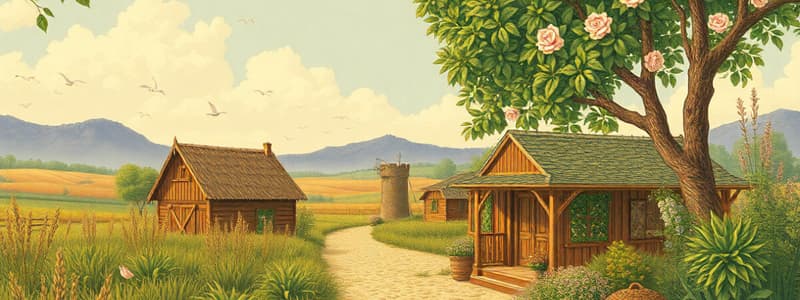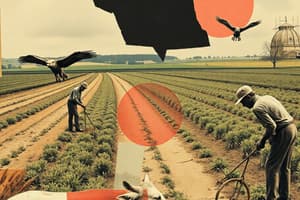Podcast
Questions and Answers
What was Jethro Tull's main contribution to agriculture?
What was Jethro Tull's main contribution to agriculture?
- Popularizing root crops such as parsnips.
- Developing a plough with an iron share.
- Creating a seed drill to plant seeds in rows. (correct)
- Inventing the first threshing machine.
What was one of the advantages of the enclosure system?
What was one of the advantages of the enclosure system?
- It limited the scope for farming experiments.
- It eliminated the need for banks in financing improvements.
- It allowed wealthy landlords to spend less on fencing.
- It forced many independent farmers to sell their lands. (correct)
Who is credited with the invention of the Rotherham plough?
Who is credited with the invention of the Rotherham plough?
- Robert Ransome.
- James Small.
- Joseph Foljambe. (correct)
- Patrick Bell.
In which year did Robert Ransome establish a factory for agricultural machinery?
In which year did Robert Ransome establish a factory for agricultural machinery?
What method of sowing seeds did Jethro Tull aim to improve?
What method of sowing seeds did Jethro Tull aim to improve?
What type of crops saw increased variety during the eighteenth century?
What type of crops saw increased variety during the eighteenth century?
Which of the following machines did Andrew Meikle produce?
Which of the following machines did Andrew Meikle produce?
Which book is most famous for describing Jethro Tull's approach to farming?
Which book is most famous for describing Jethro Tull's approach to farming?
What was the primary focus of Robert Bakewell's stock breeding methods?
What was the primary focus of Robert Bakewell's stock breeding methods?
Which crop is included in the Norfolk four-course rotation system introduced by Charles Townshend?
Which crop is included in the Norfolk four-course rotation system introduced by Charles Townshend?
What significant contribution did Thomas Coke make to farming practices?
What significant contribution did Thomas Coke make to farming practices?
What was the outcome of implementing the crop rotation method by Charles Townshend?
What was the outcome of implementing the crop rotation method by Charles Townshend?
Which crop in the Norfolk rotation system is categorized as a soil exhausting crop?
Which crop in the Norfolk rotation system is categorized as a soil exhausting crop?
How did Charles Townshend enhance animal husbandry on his lands?
How did Charles Townshend enhance animal husbandry on his lands?
What innovation did Thomas Coke introduce regarding animal feed?
What innovation did Thomas Coke introduce regarding animal feed?
What was one of Robert Bakewell’s significant shifts in stock breeding?
What was one of Robert Bakewell’s significant shifts in stock breeding?
What was one major issue with the old open field system of agriculture?
What was one major issue with the old open field system of agriculture?
What factor contributed to the increasing need for food during the agrarian revolution?
What factor contributed to the increasing need for food during the agrarian revolution?
What was the purpose of the Enclosure Acts during the agrarian revolution?
What was the purpose of the Enclosure Acts during the agrarian revolution?
What transportation improvements supported the agrarian revolution?
What transportation improvements supported the agrarian revolution?
What was a significant social outcome of the agrarian revolution?
What was a significant social outcome of the agrarian revolution?
How did the customs of the village affect farming during the agrarian revolution?
How did the customs of the village affect farming during the agrarian revolution?
What motivated industrialists to invest in agriculture during the revolution?
What motivated industrialists to invest in agriculture during the revolution?
What was one effect of reallocating land under the Enclosure Acts?
What was one effect of reallocating land under the Enclosure Acts?
What method did Bakewell use to produce the New Leicester sheep?
What method did Bakewell use to produce the New Leicester sheep?
What notable characteristic is associated with John Ellman's improved Southdown sheep?
What notable characteristic is associated with John Ellman's improved Southdown sheep?
Which breed of cattle did the Colling brothers develop?
Which breed of cattle did the Colling brothers develop?
What was a primary purpose of the Board of Agriculture, where Arthur Young served as Secretary?
What was a primary purpose of the Board of Agriculture, where Arthur Young served as Secretary?
What publication did Arthur Young edit from 1784 to 1804?
What publication did Arthur Young edit from 1784 to 1804?
What did George, known as 'Farmer George', establish at Windsor?
What did George, known as 'Farmer George', establish at Windsor?
During which years did Arthur Young farm at locations like Bradfield and Sandford Hall?
During which years did Arthur Young farm at locations like Bradfield and Sandford Hall?
What was a consequence of Arthur Young's writings on agriculture?
What was a consequence of Arthur Young's writings on agriculture?
Study Notes
The Agrarian Revolution
- The Agrarian Revolution refers to significant changes in English agricultural methods between the late 17th and early 18th centuries.
Causes
- The open field system was inefficient as only two out of three fields were cultivated each year.
- Land fragmentation (scattered holdings) wasted time, making travel to remote plots difficult.
- Rigid village customs hindered farmers from adopting new methods.
- Population growth fueled a demand for more food which could not be met by the old system.
- The rise of industrial towns further increased demand for food.
- Commercial attitude toward agriculture grew with farming societies and investors seeking profit.
- Improved transport enabled farmers to deliver their products to cities with turnpike roads, canals, and railways.
Developments
- Enclosure system consolidated fragmented strips of land into larger units, fenced off for individual ownership.
- Enclosure Acts passed by George II and III facilitated the process by appointing commissioners to reallocate land.
- While wealthy businessmen purchased land from poorer peasants, the yeomen (small landowning farmers) class eventually disappeared.
Enclosure Impact
- The English banking system expanded as landlords borrowed money for fencing and improvements.
- The enclosure system allowed entrepreneurial farmers to experiment with new methods.
- Many small farmers were forced to sell their land and become laborers or migrate to cities for work.
Machinery
- Jethro Tull (1674-1740) was a pioneer in agricultural science.
- Invented the seed drill for even seed distribution in rows.
- Advocated for selective seed choice.
- Published "The Horse Hoeing Husbandry" (1733) on his methods.
- Joseph Foljambe introduced the Rotherham plough (1730) with an iron share and coulter.
- Widely used in northern England, requiring fewer oxen to pull.
- Modified by James Small of Berwick shire.
- Robert Ransome founded an agricultural machinery factory in Ipswich (1785).
- Produced cast iron plough shares.
- Andrew Meikle created the first practical threshing machine (1784).
- Patrick Bell invented a reaping machine (1826).
Agricultural Technology
- Root crops (parsnips, swedes, mangolds) and forage crops (lucerne, clover) gained popularity, reflecting the demand for livestock.
- Crop rotation (Norfolk system) was introduced by Charles Townshend (1674-1738).
- Allowed continuous cultivation without fallow periods.
- Increased yield per acre by rotating turnips, barley, clover, and wheat.
- Enabled more livestock to be raised, leading to increased manure for better soil fertility.
Animal Breeding
- Robert Bakewell revolutionized livestock breeding.
- Focused on meat production rather than only wool.
- Selective breeding (in-and-in methods) improved the quality of cattle, sheep, and horses.
- Created the New Leicester sheep, known for rapid weight gain but with high fat content.
- Also developed the Longhorn cattle and a distinct breed of black carthorses.
- John Ellman used in-and-in breeding for the improved Southdown sheep, valued for its fine mutton and suitability for turnip grazing.
- Charles and Robert Colling developed the Durham Shorthorn cattle (Ketton), producing lean meat and abundant milk.
- George Culley of Northumbria also bred Shorthorn cattle concurrently with the Colling brothers.
Royal Patronage and Advocacy
- King George III supported the movement and established a model farm at Windsor.
- Arthur Young, a prominent agricultural writer, advocated for new methods.
- Published works like "A Six Weeks Tour through the Southern Counties" (1768), "The Farmer's Calendar" (1771), and edited "The Annals of Agriculture" (1784-1804).
- Appointed Secretary to the Board of Agriculture (1793) to promote good farming practices for increased food production during the war with France.
Studying That Suits You
Use AI to generate personalized quizzes and flashcards to suit your learning preferences.
Related Documents
Description
Explore the transformative changes in agricultural practices during the Agrarian Revolution in England. This quiz covers the causes such as inefficiencies in the open field system and population growth, as well as key developments like the enclosure system and transportation improvements.




